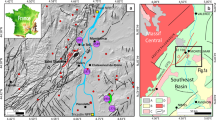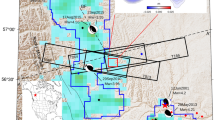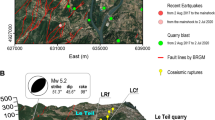Abstract
Our understanding of the earthquake process requires detailed insights into how the tectonic stresses are accumulated and released on seismogenic faults. We derive the full vector displacement field due to the Bam, Iran, earthquake of moment magnitude 6.5 using radar data from the Envisat satellite of the European Space Agency. Analysis of surface deformation indicates that most of the seismic moment release along the 20-km-long strike-slip rupture occurred at a shallow depth of 4–5 km, yet the rupture did not break the surface. The Bam event may therefore represent an end-member case of the ‘shallow slip deficit’ model, which postulates that coseismic slip in the uppermost crust is systematically less than that at seismogenic depths (4–10 km). The InSAR-derived surface displacement data from the Bam and other large shallow earthquakes suggest that the uppermost section of the seismogenic crust around young and developing faults may undergo a distributed failure in the interseismic period, thereby accumulating little elastic strain.
This is a preview of subscription content, access via your institution
Access options
Subscribe to this journal
Receive 51 print issues and online access
$199.00 per year
only $3.90 per issue
Buy this article
- Purchase on Springer Link
- Instant access to full article PDF
Prices may be subject to local taxes which are calculated during checkout



Similar content being viewed by others
References
Massonnet, D. et al. The displacement field of the Landers earthquake mapped by radar interferometry. Nature 364, 138–142 (1993)
Peltzer, G., Crampe, F. & King, G. Evidence of nonlinear elasticity of the crust from the M w 7.6 Manyi (Tibet) earthquake. Science 286, 272–276 (1998)
Simons, M., Fialko, Y. & Rivera, L. Coseismic deformation from the 1999 M w 7.1 Hector Mine, California, earthquake, as inferred from InSAR and GPS observations. Bull. Seismol. Soc. Am. 92, 1390–1402 (2002)
Fialko, Y. Probing the mechanical properties of seismically active crust with space geodesy: Study of the co-seismic deformation due to the 1992 M w 7.3 Landers (southern California) earthquake. J. Geophys. Res. 109, doi:10.1029/2003JB002756 (2004)
Feigl, K. L. et al. Estimating slip distribution for the Izmit mainshock from coseismic GPS, ERS-1, RADARSAT and SPOT measurements. Bull. Seismol. Soc. Am. 92, 138–160 (2002)
Cakir, Z. et al. Coseismic and early post-seismic slip associated with the 1999 Izmit earthquake (Turkey), from SAR interferometry and tectonic field observations. Geophys. J. Int. 155, 93–110 (2003)
Jonsson, S., Zebker, H., Segall, P. & Amelung, F. Fault slip distribution of the 1999 M w 7.1 Hector Mine, California, earthquake, estimated from satellite radar and GPS measurements. Bull. Seismol. Soc. Am. 92, 1377–1389 (2002)
Fialko, Y., Simons, M. & Agnew, D. The complete (3-D) surface displacement field in the epicentral area of the 1999 M w 7.1 Hector Mine earthquake, southern California, from space geodetic observations. Geophys. Res. Lett. 28, 3063–3066 (2001)
Tse, S. T. & Rice, J. R. Crustal earthquake instability in relation to the depth variation of frictional slip properties. J. Geophys. Res. 91, 9452–9472 (1986)
Thatcher, W. Nonlinear strain build-up and the earthquake cycle on the San Andreas fault. J. Geophys. Res. 88, 5893–5902 (1983)
Savage, J. & Svarc, J. Postseismic deformation associated with the 1992 M w = 7.3 Landers earthquake, southern California. J. Geophys. Res. 102, 7565–7577 (1997)
Manning, C. & Ingebritsen, S. Permeability of the continental crust: Implications of geothermal data and metamorphic systems. Rev. Geophys. 37, 127–150 (1999)
Byerlee, J. Friction of rock. Pure Appl. Geophys. 116, 615–626 (1978)
Marone, C. Laboratory-derived friction laws and their application to seismic faulting. Annu. Rev. Earth Planet. Sci. 26, 643–696 (1998)
Lyons, S. & Sandwell, D. Fault creep along the southern San Andreas from interferometric synthetic aperture radar, permanent scatterers, and stacking. J. Geophys. Res. 108, doi:10:1029/2002JB001831 (2003)
Tatar, M. et al. Aftershocks study of the 26 December 2003 Bam earthquake. J. Seismol. Earthquake Eng. (in the press)
Rosen, P. et al. Synthetic aperture radar interferometry. Proc. IEEE 88, 333–382 (2000)
Michel, R. & Avouac, J.-P. Measuring ground displacements from SAR amplitude images: Application to the Landers earthquake. Geophys. Res. Lett. 26, 875–878 (1999)
Peltzer, G., Rosen, P., Rogez, F. & Hudnut, K. Poroelastic rebound along the Landers 1992 earthquake surface rupture. J. Geophys. Res. 103, 30131–30145 (1998)
Jacobs, A., Sandwell, D., Fialko, Y. & Sichoix, L. The 1999 (M w 7.1) Hector Mine, California, earthquake: Near-field postseismic deformation from ERS interferometry. Bull. Seismol. Soc. Am. 92, 1433–1442 (2002)
Fialko, Y. Evidence of fluid-filled upper crust from observations of post-seismic deformation due to the 1992 M w 7.3 Landers earthquatek. J. Geophys. Res. 109, doi:10.1029/2004JB002985 (2004)
Chinnery, M. A. The deformation of the ground around surface faults. Bull. Seismol. Soc. Am. 51, 355–372 (1961)
Talebian, M. et al. The 2003 Bam (Iran) earthquake: Rupture of a blind strike-slip fault. Geophys. Res. Lett. 31, L11611, doi:10.1029/2004GL020058 (2004)
Heaton, T. Evidence for and implications of self-healing pulses of slip in earthquake rupture. Phys. Earth Planet. Inter. 64, 1–20 (1990)
Boatwright, J. Spectral theory for circular seismic sources—simple estimates of source dimension, dynamic stress drop, and radiated seismic energy. Bull. Seismol. Soc. Am. 70, 1–27 (1980)
Savage, J. & Lisowski, M. Inferred depth of creep on the Hayward fault, central California. J. Geophys. Res. 98, 787–793 (1993)
Delouis, B., Giardini, D., Lundgren, P. & Salichon, J. Joint inversion of InSAR, GPS, teleseismic, and strong-motion data for the spatial and temporal distribution of earthquake slip: Application to the 1999 Izmit mainshock. Bull. Seismol. Soc. Am. 92, 278–299 (2002)
Okada, Y. Surface deformation due to shear and tensile faults in a half-space. Bull. Seismol. Soc. Am. 75, 1135–1154 (1985)
Wang, R., Martin, F. & Roth, F. Computation of deformation induced by earthquakes in a multi-layered elastic crust—FORTRAN programs EDGRN/EDCMP. Comp. Geosci. 29, 195–207 (2003)
Marone, C., Scholz, C. & Bilham, R. On the mechanics of earthquake afterslip. J. Geophys. Res. 96, 8441–8452 (1991)
Williams, P., McGill, S., Sieh, K., Allen, C. & Louie, J. Triggered slip along the San Andreas fault after the 8 July 1986 North Palm-Springs earthquake. Bull. Seismol. Soc. Am. 78, 1112–1122 (1988)
Bilham, R. Surface slip subsequent to the 24 November 1987 Superstition Hills, California, earthquake monitored by digital creepmeters. Bull. Seismol. Soc. Am. 79, 424–450 (1989)
Sandwell, D., Sichoix, L., Agnew, D., Bock, Y. & Minster, J.-B. Near real-time radar interferometry of the M w 7.1 Hector Mine Earthquake. Geophys. Res. Lett. 27, 3101–3104 (2000)
Sharp, R., Rymer, M. & Lienkaemper, J. Surface displacement on the Imperial and Superstition Hills faults triggered by the Westmoreland, California, earthquake of 26 April 1981. Bull. Seismol. Soc. Am. 76, 949–965 (1986)
Bürgmann, R. et al. Earthquake potential along the northern Hayward fault, California. Science 289, 1178–1182 (2000)
Peltzer, G., Crampe, F., Hensley, S. & Rosen, P. Transient strain accumulation and fault interaction in the Eastern California shear zone. Geology 29, 975–978 (2001)
Lettis, W., Wells, D. & Baldwin, J. Empirical observations regarding reverse earthquakes, blind thrust faults, and quaternary deformation: Are blind thrust faults truly blind? Bull. Seismol. Soc. Am. 87, 1171–1198 (1997)
Dolan, J., Christofferson, S. & Shaw, J. Recognition of paleoearthquakes on the Puente Hills blind thrust fault, California. Science 300, 115–118 (2003)
Sylvester, A. Strike-slip faults. Geol. Soc. Am. Bull. 100, 1666–1703 (1988)
Ben-Zion, Y. et al. A shallow fault-zone structure illuminated by trapped waves in the Karadere-Duzce branch of the North Anatolian Fault, western Turkey. Geophys. J. Int. 152, 699–717 (2003)
Fialko, Y. et al. Deformation on nearby faults induced by the 1999 Hector Mine earthquake. Science 297, 1858–1862 (2002)
Hickman, S. & Zoback, M. Stress orientations and magnitudes in the SAFOD pilot hole. Geophys. Res. Lett. 31, L15S12, doi:10.1029/2004GL20043 (2004)
Sieh, K. E. & Jahns, R. H. Holocene activity of the San Andreas fault at Wallace Creek, California. Geol. Soc. Am. Bull. 95, 883–896 (1984)
Oskin, M. & Iriondo, A. Large-magnitude transient strain accumulation on the Blackwater fault, Eastern California shear zone. Geology 32, 313–316 (2004)
Rosen, P., Hensley, S., Peltzer, G. & Simons, M. Updated repeat orbit interferometry package released. Eos 85, 47 (2003)
Scharoo, R. & Visser, P. Precise orbit determination and gravity field improvement for the ERS satellites. J. Geophys. Res. 103, 8113–8127 (1998)
Farr, T. & Kobrick, M. Shuttle Radar Topography Mission produces a wealth of data. AGU Eos 81, 583–585 (2000)
Acknowledgements
We thank R. Bürgmann for comments. This work was supported by the National Science Foundation and the Southern California Earthquake Center. Original Envisat ASAR data are copyright of the European Space Agency, acquired under CAT-1 research category. Aftershock locations were provided by M. Tatar, and coordinates of the geologically mapped faults by M. Heydari. P.R. conducted his work at JPL/Caltech, under contract with NASA.
Author information
Authors and Affiliations
Corresponding author
Ethics declarations
Competing interests
Reprints and permissions information is available at npg.nature.com/reprintsandpermissions. The authors declare no competing financial interests.
Supplementary information
Supplementary Figure 1
Shaded relief map of the epicentral area of the Bam earthquake. (JPG 41 kb)
Supplementary Figure 2
Slip distribution from the inversion of the Envisat ASAR data for the layered elastic half-space model. (JPG 24 kb)
Supplementary Figure 3
Sub-sampled ASAR data used in the inversion; best-fitting models; and residuals after subtracting the best-fitting models from the data. (JPG 80 kb)
Supplementary Legends
Legends for Supplementary Figs 1-3. (DOC 19 kb)
Rights and permissions
About this article
Cite this article
Fialko, Y., Sandwell, D., Simons, M. et al. Three-dimensional deformation caused by the Bam, Iran, earthquake and the origin of shallow slip deficit. Nature 435, 295–299 (2005). https://doi.org/10.1038/nature03425
Received:
Accepted:
Issue Date:
DOI: https://doi.org/10.1038/nature03425
This article is cited by
-
Near-surface termination of upward-propagating strike-slip ruptures on the Yangsan Fault, Korea
Scientific Reports (2023)
-
Dynamically estimating deformations with wrapped InSAR based on sequential adjustment
Journal of Geodesy (2023)
-
Spatiotemporal Distributions of b Values Following the 2019 Mw 7.1 Ridgecrest, California, Earthquake Sequence
Pure and Applied Geophysics (2023)
-
Dynamic rupture forewarned by a displacement field criterion
International Journal of Fracture (2023)
-
Complete three-dimensional coseismic displacements due to the 2021 Maduo earthquake in Qinghai Province, China from Sentinel-1 and ALOS-2 SAR images
Science China Earth Sciences (2022)
Comments
By submitting a comment you agree to abide by our Terms and Community Guidelines. If you find something abusive or that does not comply with our terms or guidelines please flag it as inappropriate.



